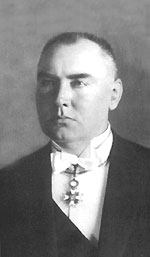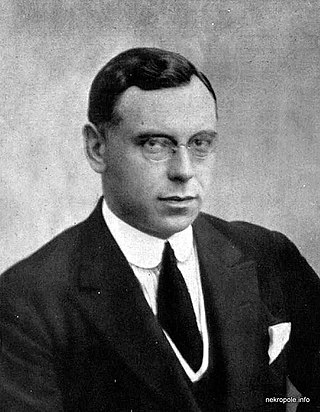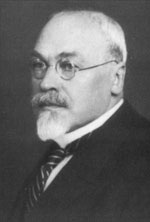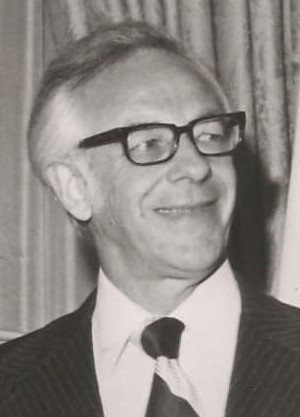
Kārlis Augusts Vilhelms Ulmanis was a Latvian politician. He was one of the most prominent Latvian politicians of pre-World War II Latvia during the Interwar period of independence from November 1918 to June 1940. He served four times as prime minister, the last time as the head of an authoritarian regime, during which he subsequently also adopted the title of President of Latvia. The legacy of his dictatorship continues to divide public opinion in Latvia today.

Guntis Ulmanis, also known as Guntis Rumpītis from 1949 to 1989, is a Latvian politician and the fifth President of Latvia from 1993 to 1999.

Jānis Kristaps Čakste was a Latvian politician and lawyer who served as the first head of an independent Latvian state as the Chairman of the People's Council (1918–1920), the Speaker of the Constitutional Assembly (1920–1922), and as the first President of Latvia (1922–1927).

Alberts Kviesis was a Latvian politician who served as third President of Latvia from 1930 to 1936.

Zigfrīds Anna Meierovics was a Latvian politician and diplomat who served as the first Foreign Minister of Latvia from its independence until 1924 and again from December of the same year until his death. He also served two terms as the Prime Minister of Latvia from June, 1921 to January, 1923 and from June 1923 to January, 1924. He was one of the founders of the Latvian Farmers' Union, one of Latvia's oldest political parties.

The president of Latvia is head of state and commander-in-chief of the National Armed Forces of the Republic of Latvia.

Indirect presidential elections were held in Latvia on 2 June 2011. Incumbent president Valdis Zatlers was standing again, as well as Andris Bērziņš, a former head of SEB Unibanka ; Bērziņš was nominated by five Saeima members of the Union of Greens and Farmers just two days before the nomination deadline, although the party was assumed to back Zatlers for re-election.

Indirect presidential elections were held in Latvia on 3 June 2015. Raimonds Vējonis of the Green Party was elected President and took office on 8 July. According to the European Green Party, he is the first of their members to become a head of state of a European Union member state.

Indirect presidential elections were held in Latvia on 29 May 2019.

Indirect presidential elections were held in Latvia on 20 June 2003. The incumbent, Vaira Vīķe-Freiberga, was re-elected by the Saeima to serve a second four-year term with an overwhelming majority.

Ilga Kreituse is a Latvian politician, historian, and former Speaker of the Saeima.

The 1922 presidential elections in Latvia took place on November 14, 1922. By agreement between the Latvian Social Democratic Workers' Party and the Latvian Farmers' Union, Jānis Čakste was nominated as the sole candidate and elected the 1st President of Latvia with 92 votes in favor and 6 abstentions. The President was elected by the 1st Saeima.

The 1927 presidential elections in Latvia took place in April 5, 7, and 8, 1927, during the term of the 2nd Saeima. The elections took place in extraordinary circumstances, as the former President of Latvia, Jānis Čakste, had died while holding the office of President. The election of the president this time proved to be very difficult as only after nine unsuccessful votes in three Saeima sittings for the 2nd President of Latvia was Gustavs Zemgals elected.

The 1930 presidential elections in Latvia took place in April 8 and 9, 1930, during the term of the 3rd Saeima. Incumbent president Gustavs Zemgals refused to run again, so, like in the 1927 elections, many rounds of voting were required until the Latvian Farmers' Union candidate Alberts Kviesis was elected president and became the 3rd President of Latvia.

The 1933 presidential elections in Latvia took place on April 4, 1933, during the term of the 4th Saeima. In the first round of voting, incumbent President Alberts Kviesis was re-elected President.

The 1996 presidential elections in Latvia took place on June 18, 1996. Guntis Ulmanis was re-elected President of Latvia. According to the Satversme, the President was elected by the 6th Saeima.

The 1999 presidential elections in Latvia took place on June 17, 1999. After no candidate collected the required number of votes in several ballots, a break was announced at the election session, during which Raimonds Pauls, who had received the most support at the time, withdrew his candidacy. After the break, the sitting was resumed with new candidates and Vaira Vīķe-Freiberga was elected the 6th President of Latvia.

Livonia is one of the five multi-member constituencies of the Saeima, the national legislature of Latvia. The constituency was established in 1922 when the Saeima was established following Latvia's independence from the Soviet Union. It consists of the city of Jūrmala and municipalities of Ādaži, Alūksne, Cēsis, Gulbene, Ķekava, Limbaži, Madona, Mārupe, Ogre, Olaine, Ropaži, Salaspils, Saulkrasti, Sigulda, Smiltene, Valka, Valmiera and Varakļāni in the region of Livonia. The constituency currently elects 26 of the 100 members of the Saeima using the open party-list proportional representation electoral system. At the 2022 parliamentary election it had 396,278 registered electors.

Gunārs Meierovics was a Latvian politician and the youngest son of the second Prime Minister of Latvia Zigfrīds Anna Meierovics. Meierovics was also a candidate for the 1993 Latvian presidential election.
Indirect presidential elections were held in Latvia on 31 May 2023 to elect the President of Latvia, who is the country's head of state.



















